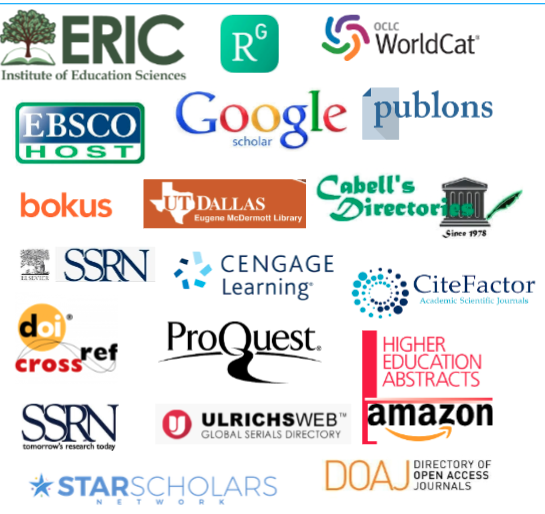Interdisciplinary Connections:
Evaluating Collaboration between AFNR and Leadership, Mathematics, and Science Educators
DOI:
https://doi.org/10.32674/jise.v7i2.1084Keywords:
collaboration, interdisciplinary teaching and learning, School-based Agriculture Food and Natural Resources EducationAbstract
Agriculture, food, and/or natural resources (AFNR) content offers a tremendous context for interdisciplinary teaching and learning. Collaboration between AFNR and core content area educators has been recommended to increase interdisciplinarity in school-based AFNR Education; however, existing research lacks an empirical investigation of the relationship between interdisciplinary collaboration and outcomes associated with interdisciplinary teaching in school-based AFNR Education. Therefore, the current study explores the scope of collaboration between AFNR, leadership, mathematics, and science educators and the relationship between collaboration and interdisciplinary teaching in school-based AFNR Education. Findings indicate opportunities to initiate and strengthen interdisciplinary communities of practice through purposeful interactions, especially regarding length of interactions between AFNR and core content area educators. Recommendations for practitioners, teacher educators, and researchers are provided.
Downloads
References
Balschweid, M. A. (2002). Teaching biology using agriculture as the context: Perceptions of high school students. Journal of Agricultural Education, 43(2), 56–67. doi:10.5032/jae.2002.02056
Cohen, J. (1988). Statistical power analysis for the behavioral sciences. Hillsdale, NJ: Erlbaum.
Connors, J., & Elliot, J. (1994). Teacher Perceptions of Agriscience and natural resources curriculum. Journal of Agricultural Education, 35 (4), 15-19. doi:10.5032/jae.1994.04015
Dillman, D. A. (2007). Mail and internet surveys: The tailored design method (2nd ed.). Hoboken, NJ: John Wiley & Sons, Inc.
Fraenkel, J. R., & Wallen, N. E. (2000). How to design and evaluate research in education. New York, NY: McGraw-Hill.
Handy, K. & Braley, R. (2012). Analysis of educators’ perceptions regarding career and technical education, academic content, and blended curricula. Journal of Interdisciplinary Studies in Education, 1(1), 16-27.
Haynes, J. C., Robinson, J. S., Edwards, M. C., & Key, J. P. (2012). Assessing the effect of using a science-enhanced curriculum to improve agriculture students’ science scores: A causal comparative study. Journal of Agricultural Education, 53(2), 15-27. doi:10.5032/jae.2012.02015
Hibbert, P., Huxham, C., & Smith Ring, P. (2008). Managing collaborative inter-organizational relations. In Cropper, S., Huxham, C., Ebers, M., & Smith Ring, P. (Eds.) The Oxford handbook of inter-organizational relations. doi:10.1093/oxfordhb/9780199282944.003.0015
Lindner, J. R., Murphy, T. H., & Briers, G. E. (2001). Handling nonresponse in social science research. Journal of Agricultural Education, 42(4), 43-53. doi:10.5032/jae.2001.04043
McKim, A. J., Pauley, C. M., Velez, J. J., & Sorensen, T. J. (2017). Leadership learning opportunities in agriculture, food, and natural resources education: The role of the teacher. Journal of Agricultural Education, 58(3), 84-100. https://doi.org/10.5032/jae.2017.03084
McKim, A. J., Pauley, C. M., Velez, J. J., & Sorensen, T. J. (2018). Interdisciplinary learning opportunities in agriculture, food, natural resources, and science: The role of the teacher. Journal of Agricultural Education, 59(2), 179-196. https://doi.org/10.5032/jae.2018.02179
McKim, A. J., Velez, J. J., Everett, M. W., & Sorensen, T. J. (2017). The role of teachers in facilitating mathematics learning opportunities in agriculture, food, and natural resources. Journal of Agricultural Education, 58(3), 203-218. https://doi.org/10.5032/jae.2017.03203
McKim, A. J., Velez, J. J., Lambert, M. D., & Balschweid, M. A. (2017). A philosophical review of science and society within agricultural education. Journal of Agricultural Education, 58(2), 98-110. doi:10.5032/jae.2017.02098
Morgan, A. C., Fuhrman, N. E., King, D. L., Flanders, F. B., & Rudd, R. D. (2013). Leadership curriculum and materials used by high school agricultural science teachers: A national study of the pre-lifeknowledge days. Journal of Agricultural Education, 54(1), 72-82. doi:10.5032/jae.2013.01072
Morgan, A. C., Parr, B., & Fuhrman, N. (2011). Enhancing collaboration among math and career and technical education teachers: Is technology the answer? Journal of Career and Technical Education, 26(2), 77-89. http://doi.org/10.21061/jcte.v26i2.527
Myers, B. E., & Osborne, E. W. (2005). Conceptual Model for Strengthening Academic Learning through Agricultural Education Research. Department of Agricultural Education and Communication, University of Florida, Gainesville.
Myers, B. E. & Thompson, G. W. (2009). Integrating academics into agriculture programs: A delphi study to determine perceptions of the national agriscience teacher ampassador academy participants. Journal of Agricultural Education, 50(2), 75-86. doi:10.5032/jae.2009.02075
National Research Council. (2009). Transforming agricultural education for a changing world. Washington, DC: National Academies Press.
Newman, M. E. & Johnson, D. M. (1993). Perceptions of Mississippi secondary agricultural teachers concerning pilot agriscience courses. Journal of Agricultural Education, 34(3), 49-58. doi:10.5032/jae.1993.03049
Osborne, E. W., & Dyer, J. E. (1998). Attitudes of Illinois high school science teachers toward educational programs in agriculture. Journal of Agricultural Education, 39(1), 8–16. doi:10.5032/jae.1998.01008
Phipps, L. J., Osborne, E. W., Dyer, J. E., & Ball, A. (2008). Handbook on agricultural education in public schools (6th ed.), Clifton, New York: Delmar.
Scherer, H. H., McKim, A. J., Wang, H., DiBenedetto, C., & Robinson, K. (2017). Making sense of the buzz: Providing a taxonomy of “STEM” in agriculture, food, and natural resources education. Proceedings of the American Association for Agricultural Education Research Conference, San Luis Obispo, CA, 44, 495-512.
Stephenson, L. G., Warnick, B. K., & Tarpley, R. S. (2008). Collaboration between science and agriculture teachers. Journal of Agricultural Education, 49(4), 106-119. doi:10.5032/jae.2008.04106
Stubbs, E. A., & Myers, B. E. (2015). Multiple case study of STEM in school-based agricultural education. Journal of Agricultural Education, 56(2), 188-203. doi:10.5032/jae.2015.02188
Vangen, S., & Huxham, C. (2005). Managing to collaborate: The theory and practice of collaborative advantage. Oxon: Routledge
Vangen, S., & Huxham, C. (2014). “Building and using the theory of collaborative advantage.” In Agranoff, R., Mandell, M. P., & Keast, R., (Eds.), Network theory in the public sector: Building new theoretical frameworks (51-67). New York: Routledge
Wang, H.-H. & Knobloch, N. A. (2018). Levels of STEM integration through agriculture, food, and natural resources. Journal of Agricultural Education, 59(3), 258-277. https://doi.org/10.5032/jae.2018.03258
Warnick, B. K., & Thompson, G. W. (2007). Barriers, support, and collaboration: A comparison of science and agriculture teachers’ perceptions regarding integration of science into the agricultural education curriculum. Journal of Agricultural Education, 48(1), 75-85. doi:10.5032/jae.2007.01075
Wenger, E. (2009). “A social theory of learning.” In Illeris, K., (Ed.), Contemporary theories of learning: Learning theorists… in their own words (209-218). Oxon: Routledge







